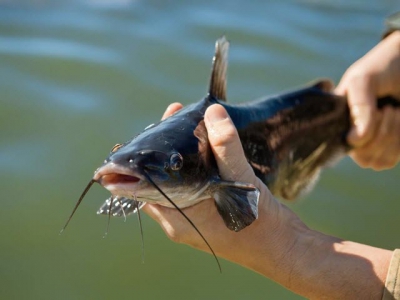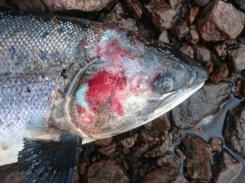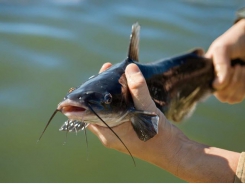Ich (White Spot Disease) - Part 2

How does Ich kill fish?
Scientists are not sure exactly how Ich kills fish, but several observations give clues to what is occurring during Ich infections. The top layer of the gill cells, the epithelium, reacts to an Ich invasion by thickening, and this results in a restriction of the oxygen flow from the water to the blood in the gills. The respiratory folds of the gills, the lamellae, also become deformed, reducing the transfer of oxygen. The shear numbers of Ich organisms covering the gills also causes a mechanical blockage of oxygen transfer. These conditions combine to stress the fish by hindering respiration.
The epithelial layer of the gill may separate and cause loss of electrolytes, nutrients and fluids from the fish, making it difficult for the fish to regulate the water concentration in its body. Secondary bacteria and fungi also invade the fish more easily while it is impaired from the Ich infection.
Prevention
In spite of strict preventive measures, Ich can still make its way into a fish production system. Attempts should be made, however, to prevent the entry of wild fish into a fish culture pond. All species of freshwater fish can carry the Ich parasite. The end of the drain pipe on the outside of a pond should be at least 2 feet above the water level in the discharge channel or drain canal. Wild or “trash” fish, such as green sunfish, living in a drain canal are able to swim upstream in water discharging from drain pipes that are close to the water level in the drain canal.
Filters should be used when river water is the source for filling a pond. Although filters such as saran cloth may not keep out parasites, they can prevent infected wild fish from entering the pond. Alogical strategy is to wait at least 3 days before stocking fish when a pond is filled through a filter; this should allow any juvenile Ich cells, which may have accidentally entered the pond, to die in the absence of fish hosts. A longer time would be needed if water temperatures were lower than 50oF. Acopper sulfate treat- ment could also be applied to the newly filled pond to kill any tomonts or theronts that happen to be in the water.
Be cautious when introducing a new batch of fish into a pond. Examine them closely for any signs of disease (submitting a sample for examination by a qualified fish health professional is recommended). If possible, quarantine the new fish for a week or more of close observation before mixing them with fish already in a pond. Equipment used in an infected pond should not be used in a healthy pond unless it is first disinfected or dried in the sun.
If a pond has a history of Ich infections or is very close to waters with wild fish, treat the pond as a preventive measure. Three to four applications of a treatment (discussed in the next section) can be applied at 7- to 10- day intervals just prior to the time of year when Ich commonly occurs in that particular pond. Additionally, maintaining wellnourished fish helps significantly in preventing Ich. It is not unusual for emaciated, starved fish to become infected with Ich.
Treatment
Because not all stages in the life cycle of Ich are affected by treatments, multiple treatments must be administered to catch individual Ich organisms in the vulnerable stages of their life cycle. For example, during the first day when a chemical is added to the water to kill Ich, only a certain percentage of Ich organisms will be susceptible to the chemical. Two days later many of the surviving Ich organisms, which were embedded in the skin, will be entering the vulnerable stage of their life cycle; chemical treatment on this day will kill these suscep- tible organisms. In order to catch all the Ich organisms in a “treatable” stage, from three to seven treatments might be needed (Table 1) depending on water tem- perature. Treatment effectiveness should be evaluated by a fish health professional after the third treatment to decide whether to continue with the treatment schedule. Mortality rates should be observed, and samples of fish from the infected pond should be examined for Ich under a microscope.
| Table 1 |
|
| Water temperature (ºF) | Treatment interval |
| 75ºand higher | Treat every day |
| 65º to 74º | Treat every other day |
| 55º to 64º | Skip 2 days between treatments |
| 45º to 54º | Skip 3 or 4 days between treatments |
The spacing of treatments varies with temperature. Table 1 can serve as a guide for an effective treatment.
Some fish health professionals believe treatments should be applied every day, even in cooler weather, instead of skipping days in between.
Ich appears to have a distinct tem- perature range in which it is infectious (see Life Cycle of Ich). It has been observed that temperature changes of 15ºF or more above or below the temperature at which an Ich case is detected will end the disease episode regardless of the number of treatments made. In some cases, one or two treatments may be all that is necessary to “buy time” for the fish until such a temperature change occurs.
The U. S. Food and Drug Administration has approved the use of formalin (Formalin-Fª) to control Ich on trout, salmon, catfish, largemouth bass and bluegill. At the time of this writing, FDA has also given copper sulfate (CuSO4) and potassium permanganate (KMnO4) deferred status, which means that these treatments may be used without legal prosecution, but they may lose deferred status if evidence isfound of any danger to the human consumer. No other chemicals should be used to treat Ich on food fish. Of the three therapeutants, copper sulfate is the least expensive.
Treatment rates for various chemi- cals are described below. Adding extra chemical “for good mea- sure” may kill or stress the fish being treated, while using less than the required therapeutic dose may not be effective in killing the parasites that are causing the fish to die. The person applying the treatment should protect eyes with goggles and skin with gloves and long sleeves. A respirator should be worn.
Formalin
Formalin is a solution of 37 per- cent formaldehyde in water with 6 to 15 percent methanol added as a preservative. It should be stored at temperatures above 40oF.
Formalin can be used as a bath treatment for up to an hour at 125 to 250 parts per million (ppm) (4.4 to 8.8 milliliters per 10 gallons; 32.8 to 65.5 milliliters per 10 cubic feet). The treatment rate should not exceed 167 ppm on warm warter fish when temperatures are higher than 70ºF (21ºC), or on trout and salmon when tempera- tures are above 50ºF (10ºC). Tanks should be flushed with clean, aerated water after an hour, or sooner if fish show signs of stress.
Formalin is used as a pond treat- ment at 15 to 25 ppm. This would be 4.5 to 7.5 gallons of formalin per acre-foot (an acre of water 1 foot deep). At the time of this writing, the cost of formalin was about $5.00 per gallon in large fish production areas, but can be as high as $30.00 per gallon for small quantities. At $5.00 per gallon, the cost of one treatment with 15 ppm formalin would be:
1 acre-foot x 4.5 gallons formalin/acre foot x $5.00/gallon
= $22.50 per acre-foot
If formalin costs $30.00 per gallon, the cost would rise to $135.00 per acre-foot. And at 25 ppm, the cost would range from $37.50 to $225.00 for each acre-foot treated. Formalin should be applied evenly throughout the pond.
Formalin should be handled very carefully because its fumes are dangerous and can damage the mucosal lining of the nose and throat.
Copper sulfate (CuSO4)
Copper sulfate (CuSO4), sometimes called bluestone or just “copper” is the most affordable chemical available for treating Ich, and does not pose the risk of accidentally inhaling toxic fumes (protective gear, however, is recommended as with any chemical being applied). Copper sulfate is used as an indefinite treatment (i.e., applied to the water and allowed to remain without subsequent dilution of the treatment). The treatment rate is determined by the total alkalinity concentration of the water being treated; the treatment rate of copper sulfate in ppm is equal to the total alkalinity divided by 100. For example, if the total alkalinity of a pond were 85 ppm, then the treatment rate for copper sulfate would be 85 ÷ 100 = 0.85 ppm. In a pond, the pounds of copper sulfate needed in this example would be:
acres x average depth in feet x 0.85 ppm CuSO4 x 2.7 pounds of CuSO4/acre-foot/ppm = lbs. CuSO4
In a tank measured in gallons, the grams of CuSO4 needed (when total alkalinity is 85 ppm) would be:
gallons x 0.85 ppm CuSO4 x 0.0038 grams CuSO4/gallon/ppm = g CuSO4
In a tank measured in cubic feet, the grams of CuSO4 needed (when total alkalinity is 85 ppm) would be:
cubic feet x 0.85 ppm CuSO4 x 0.0283 grams CuSO4/gallon = g CuSO4
When treating goldfish, use only 3/4 strength of the amount of copper sulfate normally used. In other words, multiply the calculated amount by 0.75 to lessen the amount of copper sulfate. Goldfish are more sensitive to this chemical. Trout, likewise, are very sensitive to CuSO4 and should be treated with a reduced quantity of the chemical; in Idaho, 1 ppm of CuSO4 is used in waters with a total alkalinity of 120 ppm. In regions of western North Carolina where total alkalinity is approximately 10 ppm, CuSO4 should be applied only with the advice of a qualified aquaculture fish disease specialist.
Copper sulfate should be distributed evenly over the pond or tank. It typically is not used in waters where the total alkalinity is less than 40 ppm or greater than 300 ppm. In low alkalinity waters, CuSO4 becomes more toxic to fish, and at a high alkalinity, the cop- per may precipitate out of solution, making the CuSO4 treatment ineffective. As a word of caution, algae blooms may be killed when CuSO4 is added to ponds; this may lead to low oxygen conditions especially during high temperatures. Fish may become stressed or die as a result.
At the time of this writing, copper sulfate costs about $0.50 to $1.00 per pound. The approximate cost of one treatment, having a total alkalinity of 85 ppm, would be:
1 acre-foot x 0.85 ppm CuSO4 x 2.7 lbs. CuSO4/acre-foot/ppm x $0.75/lb. = $1.72
Potassium permanganate (KMnO4)
Potassium permanganate (KMnO4) (often referred to as “potassium”) is an oxidizing agent that oxidizes organic materials in water, including protozoan parasites or external bacteria living on the surface of fish. It is usually used as an indefinite treatment in ponds at a rate dependent on the amount of organic material in the water. Two (2) ppm of KMnO4 is the minimum dose required to be effective against external parasites such as Ich, while waters rich in nutrients with a heavy algal bloom need a greater amount of KMnO4 for an effective treatment. (An author is aware of one case where 20 ppm KMnO4 was needed to reach an effective treatment level.) A potassium permanganate demand test is often used by aquatic biologists and Extension specialists to determine the most effective, but safe, treatment rate.
A traditional technique for deciding on the correct dose of KMnO4 is to add 2 ppm at a time until a winered color is attained in the water, and this color should persist for at least 8 hours to give an effective treatment. The person applying the potassium permanganate should make sure that the chemical fully dissolves during the application so that an accurate judgement can be made on the color in the water. On at least one occasion the water seemed to not turn red after several applications of 2 ppm of KMnO4, then suddenly the water turned an intense red color when the undissolved KMnO4 dissolved all at once, killing every fish in the pond. Usually, however, this technique of applying 2 ppm at a time works well.
Abath treatment of KMnO4 at 10 ppm for 15 to 20 minutes (about a level 1/2 teaspoon of KMnO4 per 100 gallons of water) is an effective short-term treatment. Water should be readily available to flush the tank quickly if the fish show any signs of stress.
The following example shows the calculations for the amount of KMnO4 to add to a pond that needs 2 ppm KMnO4.
1 acre-foot x 2 ppm KMnO4 x 2.7 lbs. KMnO4/acre-foot/ppm = 5.4 lbs. KMnO4
At a cost of about $2.00 per pound, this treatment would be approximately $10.80 per acre-foot (at the time of this writing).
The amount of KMnO4 to use in a tank with 300 gallons of water (before adding fish) to attain a 10 ppm concentration for a 15- to 20- minute bath treatment would be calculated as follows:
300 gallons of water x 10 ppm x 0.0038 grams KMnO4 /gallon/ppm = 111/2 grams KMnO4
Salt (sodium chloride; NaCl)
One of the best treatments and preventives for Ich has been 2 to 3 parts per thousand (ppt) of salt indefinitely. This is usually a very effective treatment for tank and recirculation systems but is not cost effective for ponds. In one recent case, however, Ich was observed to tolerate 3 ppt salt, while in another case, Ich withstood 5 ppt.
Eradicating and starting over or harvesting
Attempting to control Ich often is futile. When Ich becomes established in a pond the best approach may be to remove all fish from the water and start over. This can be done by adding hydrated lime to raise the pH to 11. Usually at least 500 pounds per surface acre is required. In waters with high total alkalinity, much more may be required. Anew batch of fish can be restocked after the pH drops to an acceptable range of 6.5 to 9. Another approach could be to remove all the fish from the water and leave the pond fish-free for a week or more at temperatures above 45oF. The water will then be free of Ich and ready to be stocked.
If the Ich-infected fish are large enough to be harvested for food, they can be seined from the pond for processing and consumption. Ich poses no human health risk because it is not infectious to man and does not reside in the edible portions of the fish.
Có thể bạn quan tâm
Phần mềm

Phối trộn thức ăn chăn nuôi

Pha dung dịch thủy canh

Định mức cho tôm ăn

Phối trộn phân bón NPK

Xác định tỷ lệ tôm sống

Chuyển đổi đơn vị phân bón

Xác định công suất sục khí

Chuyển đổi đơn vị tôm

Tính diện tích nhà kính

Tính thể tích ao hồ




 How to Safely Lower pH in Aquaponics
How to Safely Lower pH in Aquaponics  Ich (White Spot Disease) - Part 1
Ich (White Spot Disease) - Part 1